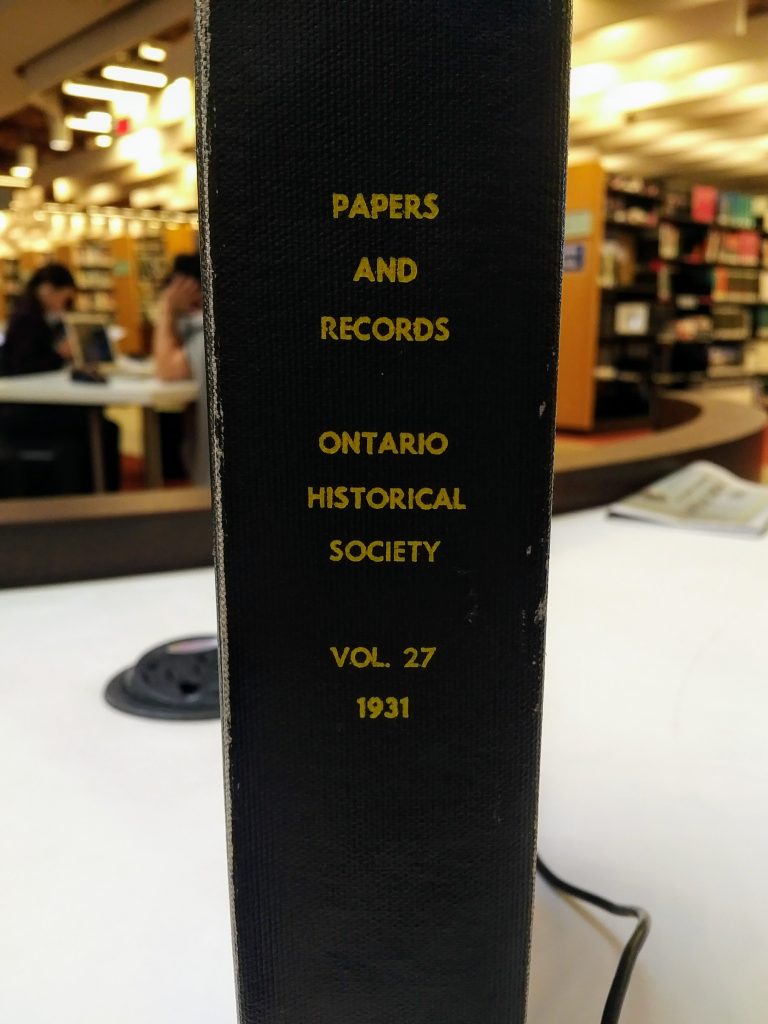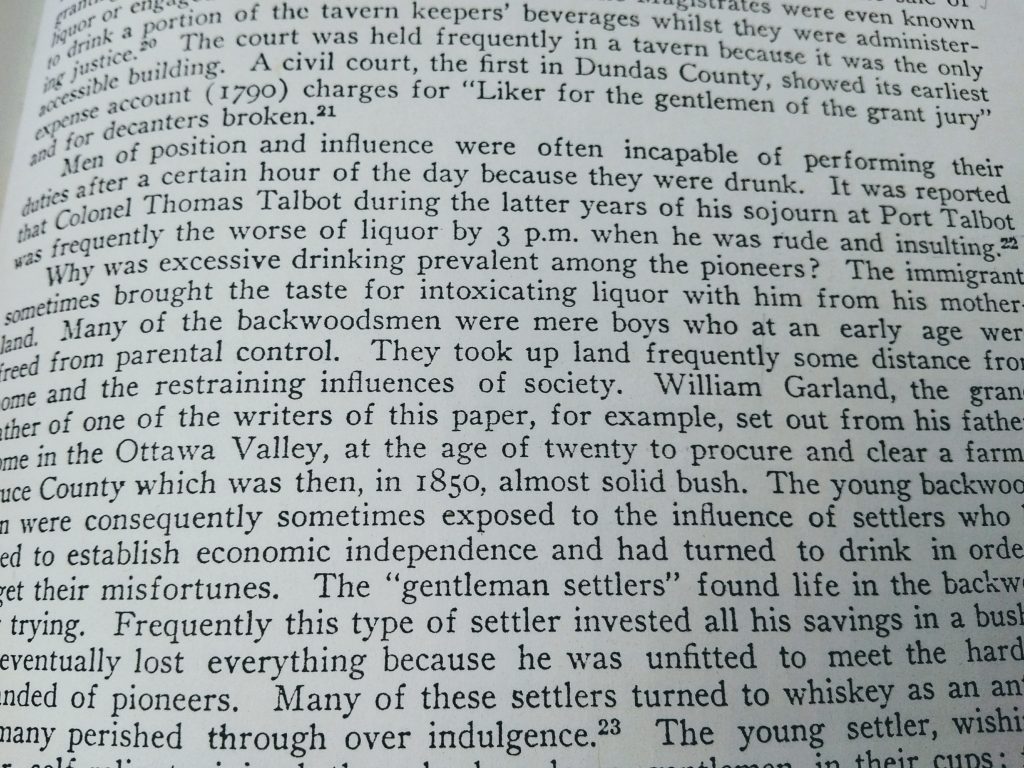In recent posts I have argued that various indices suggest the taste for whisky in Canada was abetted by the large number of Americans who settled in Upper Canada via the Loyalist influx, and Americans who came later, in their wake. I stated that into the 1840s there were about 200 distilleries in the United Province of Canada. The distillers themselves appear to have been of varied background even as no study has been done comprehensively to classify these origins. More is known of course the “marquee names” (Hiram walker, etc.) but that hardly tells the full story.
What is more clear is the original market for spirits in Upper Canada in, say, 1790-1825: people of largely American origin. Distilleries were set up in many areas where those Americans settled, especially around Lake Ontario. I’ve mentioned some in Kingston, Port Hope, Paris.
I’ve noted that people of British background also drank and made whisky, not just Scots and Irish although whiskey was typically associated with them. Some Britishers who set up distilleries here were English-born. Also, defined styles of cereal-based spirits such as whisky, Dutch gin, and London gin only emerged really after the 1700s. Whisky was to undergo yet further changes, into blended, straight, bourbon, rye, and other forms.
By this I mean, in the early days, the broad distinctions among spirits were cereal spirits (whisky, gin); fruit spirits (apples, other fruits); and rum (from sugar and molasses). Someone could make “whisky” credibly even if we might regard it today as more like gin especially at a time both were white spirits.
These are general assertions I believe to be valid, but I want to drill down to see if we can identify more specifically the origins of whisky in Ontario.
Let me say also, in investigating this question, it forms part, largely or ultimately, of academic, historical studies that are complex and multi-faceted. Generally, it is professional teachers and researchers who have the time, funding, and training to investigate such complex questions. This enables them to compile and study primary sources and the other extensive literature needed to look, say, at how taverns operated in Canada in 1810, or what people drank, how much, on what occasions, etc.
Many aspects of Canadian alcohol history have been examined by such specialists, from standpoints that include the economic, medical, agricultural, historical (settlement patterns) and technological.
So, we need to consider their work in the main. The kind of literature I considered earlier is still important though because it suggests patterns and tendencies. Thus, if the Canadian Yankees whom Susanna Moodie met in the 1830s liked whiskey, presumably their U.S. ancestors did. If Absalom Shade from Pennsylvania distilled whisky once established in Canada (1820s), he must have been familiar with it at home.
First, how many Americans came here anyway? Inferences drawn from their presence would be affected by the numbers, or rather their percentage in the population.
Historian Julia Roberts’ book In Mixed Company: Taverns and Public Life in Upper Canada (UBC Press, 2009) states that in 1815 “nearly 80%” of the colonists in Upper Canada were Loyalists or later American arrivals.
That became diluted in the following decades. But still, the Americans were almost 80% in 1815, and that’s about 30 years after the first Loyalists arrived.
So, in terms of the spirits market here into the 1820s it is fair to say most of it was “American”, and surely serviced by Americans, i.e., tavern-keepers and store owners. I’d infer that vital taste preferences were formed in this period, and the supply networks to satisfy them.
Well, what did they drink? Consider this essay from 1998 by the historian Douglas McCalla, “Customer Purchases of Alcohol at an Upper Canadian Country Store in 1808-1809 and 1828-1829”. He analyzes sales of different beverage alcohols near Brockville, Ontario, in Yonge Mills. Certainly that was Loyalist country, and his storekeeper was of Loyalist stock.
Rum outsold whisky by a fair margin in the first period. In the second the situation is totally reversed which shows the trend that took over in Upper Canada as a whole.*
This is one store in one area, and also, we don’t know how many distilleries were in striking distance of this store in the first period and then the second.* I’d think there were more in the second period since 1808 is still early days in Upper Canada. We also don’t know the relative quality of the whisky between 1808 and 1828.
But even taking the Yonge Mills store as the norm, we must recall that rum was the main spirit in the United States before the Revolution. Due to a variety of circumstances, whisky became cheaper finally but this took some time. The landmark The Alcoholic Republic: An American Tradition by W.J. Rorabaugh (1979) explains this transition and, for example, that only by 1820 did the price of rye whiskey fall by half, which helped the switch to grain spirits.
While the fiscal and economic factors to explain pricing in Canada differed in 1808 and 1828 from those in the U.S. – one assumes that rum, or sugar/molasses imports, would not have been taxed as high, in particular – even by 1808 whisky was cheaper here. This would have set the stage for the reversal of tastes, just as occurred in the U.S.
Whisky was famously distilled in Pennsylvania by the whiskey rebels of the 1790s, and in fact some whisky had been distilled in America since the 1600s. The Loyalists knew what whisky was when transitioning from rum to whisky as their preference. Unless the British presence in Upper Canada, when the Loyalists arrived, explains a taste for whisky, the Loyalists must have brought the taste, or at least enough knowledge to found the later production and consumption here of whisky.
A number of historians have stated baldly that the Loyalists brought whisky to Canada. However, when you examine the sources, they don’t really back it up. Most revert to Susanna’s Moodie’s, or other pioneer, accounts of encounters with Yankees who liked whiskey or of backwoods people getting into trouble over it. This is suggestive but not conclusive.
One study of this nature has credibility in a kind of negative sense though, in that the authors make the point the British army did not use whisky for the soldiery or regimental messes before 1800. This work, “Glass of the British Military ca. 1755-1820” (1985) is a scholarly examination of vessels used in British Forces for various purposes including for wines, beers, brandy, etc. At pg. 11 the authors state that at the end of the 18th century “whisky is not an English drink”. They attribute its use in Upper Canada specifically to Loyalists but their sources, which I checked, lead back to pioneer accounts again.
The authors, Olive Jones and Ann Smith, note that whisky was used in the 18th century in Scotland, Ireland and the U.S., but not being an English drink they conclude it must have originated in what is now Ontario with incoming Americans.
It is a theory I find, for all the reasons previously discussed, entirely logical, but smoking gun proof is lacking. The same applies to a seminal 1931 study by historians M.A. Garland and J.J. Talman in the Canadian Historical Review, Vol. 27 (1931), “Pioneer Drinking Habits and the Rise of Temperance Agitation in Upper Canada Prior to 1840″.
The study is important and continues to be cited in scholarly works, but if you read it, it doesn’t offer direct proof. There is a general statement made, not supported in the endnotes, that use of “intoxicating liquor” may have been brought by some immigrants from the “mother land”. This can be read in a number of ways, e.g., to comprehend England and include beer for example, so it’s suggestive but not definitive.
The authors do credit the United States with a lot, but ironically for inspiring the early Temperance agitation In Upper Canada via certain Protestant denominations.
The study is useful in many ways though, and is written in a clear, modern style – no Victorianese or the kind of academic jargon common today. I recommend it to anyone interested in this area.
So, we are left with where I started, which is to make reasonable inferences from available sources. Probably a good many early distillers were Loyalists or later American arrivals. The use of whiskey followed that of rum just as it did south of the border, the “same” people were using both. Whiskey was not foreign to the British mind, and a Briton whether Scots, English or Irish might go into the business if he could make a shilling. But the use of whiskey before 1800 in the United States, and the similarity of grains used there and here for whisky in the 1800s, suggests the Americans brought the taste here.
There is no other theory as persuasive, in my opinion, e.g., that whiskey was an implant of British foodways, or a local phenomenon with no reference to external factors. Our Ontario rye whisky is of American origin, in a word.
[Part II of this article follows, here].
……………………………………………………………………………………………………………….
*In this 2015 book-length study of consumer purchasing habits in Upper Canada, Douglas McCalla elaborates on his 1998 essay. He states that whiskey was more costly than rum in 1808-1809 (45 cents @ quart vs. 35 cents), which suggests that rum’s dominance in sales, at least at this store at this time, was price-driven. In 1828-1829, the price of each had fallen significantly but whiskey was now cheaper than rum by half (12.5 cents @quart vs. 25 cents), which probably explains its capture of the greater part of the market by then. Whether the accounts of this store reflect Upper Canada market conditions in general for these supplies is unknown to us, as is the full economic/tax/importation circumstances to explain these changes. However, the picture does seem broadly similar to what W.J. Rorabaugh describes for the U.S. in The Alcoholic Republic, i.e., whiskey in the first two decades on the 1800s fell considerably in price and became a more cost-effective alternative to rum.
**McCalla’s 1998 essay states distilling in the area is documented by the 1830s and that it likely occurred sooner, but this is unclear.



Not knowing as much as I should about the background of Canadians in that area I have to ask if there is much German descent there? I ask because the Germans were a massive influence on two types of spirits in the U.S.; Rye Whiskey, particularly in Pennsylavia and then later in the mid west, and also fruit brandy/typically Peach. Here in Southern Indiana I’d say a good 80 percent of the early families were originally German and their preference for Rye and Peach and the perserverance thereof even in the face of cheap corn is well documented in the history books.
Alan, some Germans came in with Loyalists, there were some African Americans too, maybe some Swiss. Most were Anglo-Saxon I believe including some Scots-Irish who are culturally and ethnically related. Rye may reflect German influence in the States, it’s hard to know though, I think it is more an inference. Eg M’Harry, Hall don’t mention it. I feel the use of raw grains in a mash may reflect Irish influence as Ireland used raw grains to distill, the Scots apparently did not.